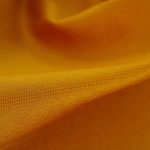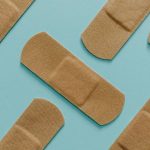When choosing gauze, you’ll find woven gauze is breathable, durable, and good for heavy drainage but can stick to wounds. Nonwoven gauze is softer, highly absorbent, and less likely to cause irritation, making it great for sensitive skin or lighter wounds. Both have pros and cons depending on your wound type and comfort needs. If you want to understand which might work best for your situation, there’s more to explore about their uses and benefits.
Table of Contents
Key Takeaways
- Woven gauze is made by interlacing cotton threads, offering breathability and durability, while nonwoven gauze is bonded synthetic fibers, providing softness and high absorbency.
- Woven gauze absorbs fluids quickly but may allow seepage; nonwoven gauze traps moisture, reducing leakage and maintaining a cleaner wound environment.
- Woven gauze promotes airflow and flexibility but can stick to wounds; nonwoven gauze is smoother and less irritating, ideal for sensitive skin.
- Woven gauze suits heavy drainage and frequent dressing changes; nonwoven gauze is better for delicate wounds requiring gentle, comfortable care.
- Choosing gauze depends on wound type, absorbency needs, comfort, and infection risk; neither is universally better, but selection should match specific wound care requirements.
Definition and Composition of Woven Gauze
Woven gauze consists of fabric made by interlacing threads in a crisscross pattern.
When you use woven gauze, you’re working with a material that’s breathable and flexible due to its open, grid-like structure. This structure allows fluid to pass through easily, which is why it’s commonly used for wound dressings.
The threads are typically made from cotton or a cotton blend, giving it softness and absorbency. Because the threads are woven tightly, woven gauze holds its shape well and can be cut without fraying too much.
Made from soft, absorbent cotton threads woven tightly, woven gauze maintains shape and resists fraying when cut.
You’ll find it useful when you need a dressing that provides protection while allowing air circulation, helping wounds heal effectively without trapping moisture.
It’s dependable and versatile for many medical applications.
Definition and Composition of Nonwoven Gauze
You’ll find nonwoven gauze is made from synthetic fibers like polyester or rayon, bonded together through heat or adhesives rather than weaving.
Its manufacturing process creates a soft, absorbent, and flexible structure that differs from traditional woven patterns.
Understanding these material choices and how they’re formed helps you see why nonwoven gauze behaves uniquely in medical settings.
Material Types Used
Many types of nonwoven gauze exist, each designed to meet specific medical needs. When you choose nonwoven gauze, you’ll typically find materials like rayon, polyester, and sometimes cotton blends.
Rayon is popular because it’s soft, highly absorbent, and gentle on wounds. Polyester adds strength and durability, making the gauze more resistant to tearing when wet. Some nonwoven gauzes combine these fibers to balance absorbency and toughness.
Unlike woven gauze, the fibers in nonwoven types aren’t intertwined but bonded, which affects texture and performance. You’ll also encounter some nonwoven gauze treated with antimicrobial agents to reduce infection risks.
Understanding these materials helps you pick the right gauze for wound care, ensuring comfort, protection, and effective healing.
Manufacturing Process Overview
Understanding how nonwoven gauze is made gives you insight into its unique properties and applications. Unlike woven gauze, nonwoven gauze forms by bonding or felting fibers together without weaving. This process creates a soft, absorbent fabric ideal for medical uses.
Here’s a quick overview of the manufacturing process components:
| Step | Description |
|---|---|
| Fiber Selection | Fibers like rayon or polyester are chosen for absorbency and strength. |
| Bonding Method | Methods like heat, chemical, or mechanical bonding join fibers securely. |
| Finishing | Treatments enhance softness, absorbency, or antimicrobial properties. |
This streamlined production results in a fabric that’s disposable, cost-effective, and reliable for wound care and hygiene.
Structural Characteristics
Although nonwoven gauze doesn’t have the interlaced threads of woven fabric, it still offers strength and flexibility through its unique fiber arrangement. Instead of weaving, fibers in nonwoven gauze are bonded together using heat, chemicals, or pressure, creating a mat-like structure.
This composition gives the gauze a consistent texture and makes it highly absorbent. When you use nonwoven gauze, you benefit from its soft feel and reduced lint production, which helps prevent contamination in wounds.
Its composition often includes synthetic fibers like polypropylene or natural fibers such as cotton, depending on the intended use. This structural design guarantees durability while maintaining gentle contact with the skin, making nonwoven gauze an excellent choice for various medical and hygiene applications.
Manufacturing Processes: Woven vs. Nonwoven
You’ll find that woven gauze is made by interlacing threads in a specific pattern, creating a strong, breathable fabric.
Nonwoven gauze, on the other hand, is produced by bonding fibers together using heat, chemicals, or pressure without weaving.
Understanding these distinct processes helps you see why each type performs differently in medical applications.
Weaving Techniques Explained
When you look closely at woven and nonwoven gauze, you’ll notice they’re made using very different techniques that affect their texture and strength.
Woven gauze is created by interlacing yarns at right angles on a loom. This process, called weaving, forms a grid-like pattern with warp (vertical) and weft (horizontal) threads crossing over and under each other.
You can expect woven gauze to have a stable, durable structure because the threads lock together tightly.
The weaving technique also allows for variations, like plain weave or twill, which change the fabric’s feel and flexibility.
This precise thread arrangement offers breathability and strength, making woven gauze ideal for medical uses where durability matters.
Understanding this helps you appreciate why woven gauze performs differently than nonwoven types.
Nonwoven Fabric Production
While woven gauze relies on interlacing threads to create its structure, nonwoven fabric production takes a different approach. Instead of weaving, nonwoven fabrics are made by bonding fibers together through mechanical, chemical, or thermal methods. This process lets you create fabrics quickly and often more cost-effectively.
Here’s how nonwoven fabric production works:
- Spunbonding: Fibers are extruded and laid into a web, then bonded with heat or pressure.
- Meltblown: Fine fibers are blown onto a conveyor to form a dense web, ideal for filtration.
- Needle punching: Fibers are mechanically entangled using barbed needles to create a strong fabric.
You’ll find nonwoven gauze offers versatility and efficient manufacturing without the complex weaving process.
Absorbency and Fluid Management Comparison
Although both woven and nonwoven gauze serve to manage wound fluids, they differ greatly in how they absorb and retain moisture.
When you choose woven gauze, you’ll notice it has a looser weave, allowing it to soak up fluids quickly but sometimes letting them pass through. This makes it effective for wounds with heavy drainage but may require frequent changing to prevent leakage.
On the other hand, nonwoven gauze uses a bonded fiber structure that traps fluids more efficiently, holding moisture within the dressing itself. This can reduce the risk of fluid seeping out and may help keep the wound environment cleaner.
Nonwoven gauze traps fluids efficiently, holding moisture and helping maintain a cleaner wound environment.
Depending on your wound’s needs, you’ll want to select gauze that balances absorbency with fluid retention for ideal healing.
Breathability and Comfort Factors
Since your skin needs to breathe to heal properly, gauze breathability plays an essential role in comfort and recovery.
Woven gauze, made from loosely woven cotton threads, allows air to pass through easily, keeping your wound dry and comfortable. Nonwoven gauze, however, consists of bonded fibers that create a denser fabric, which may trap heat and moisture more than woven types.
When choosing gauze, consider these comfort factors:
- Airflow: Woven gauze promotes better ventilation.
- Softness: Nonwoven gauze often feels smoother against sensitive skin.
- Flexibility: Woven gauze tends to be more pliable, adapting better to body contours.
Understanding these differences helps you pick gauze that supports your healing with maximum comfort.
Typical Uses and Applications in Wound Care
Choosing the right gauze goes beyond comfort—you’ll want to match the type to your wound’s needs.
Woven gauze is ideal for wounds that require frequent cleaning and dressing changes because it’s durable and easy to handle. You’ll often see it used on surgical wounds, abrasions, or lacerations where absorption and protection are essential.
On the other hand, nonwoven gauze works best when you need a soft, absorbent layer without risking fibers left behind. It’s perfect for delicate skin, burns, or sensitive wounds, providing gentle coverage that promotes healing.
By understanding these typical uses, you can select the gauze that supports effective wound care, prevents infection, and enhances recovery.
Always consider your wound type and consult healthcare advice when choosing gauze.
Advantages and Disadvantages of Woven Gauze
When you use woven gauze, you benefit from its strength and breathability, which make it a reliable choice for many wound types.
Its open weave allows air to circulate, promoting faster healing and reducing moisture buildup.
However, woven gauze can sometimes stick to wounds, causing discomfort during dressing changes.
It’s also less absorbent compared to some alternatives, which might require more frequent changes.
Here are some advantages and disadvantages to evaluate:
- Advantages: Durable, breathable, and flexible for various wound shapes.
- Disadvantages: Can adhere to wounds, potentially causing pain when removed.
- Considerations: May need additional layers for adequate absorption.
Knowing these pros and cons helps you decide if woven gauze fits your specific wound care needs.
Advantages and Disadvantages of Nonwoven Gauze
Although nonwoven gauze lacks the traditional woven texture, it offers a range of benefits that make it a versatile option for wound care.
You’ll appreciate its high absorbency and softness, which help reduce irritation and promote comfort. Nonwoven gauze is also less likely to shed fibers, minimizing the risk of contamination in your wound. Additionally, it’s often sterile and ready to use, saving you time.
However, nonwoven gauze isn’t without drawbacks. It tends to be less durable than woven gauze, so it may tear more easily during application.
Nonwoven gauze may tear more easily due to its lower durability compared to woven gauze.
Its structure can sometimes make it less breathable, potentially slowing healing for certain wounds. Still, its advantages in comfort and cleanliness often outweigh these disadvantages for many situations.
Factors to Consider When Choosing Between Woven and Nonwoven Gauze
Since each wound and situation demands specific care, you’ll need to weigh several factors before deciding between woven and nonwoven gauze. Your choice impacts healing speed, comfort, and infection risk.
Consider these key points to make the best decision:
- Wound type and location: Woven gauze suits wounds needing breathability and absorption, while nonwoven works well for sensitive or surgical wounds requiring gentle contact.
- Absorbency needs: If you expect heavy exudate, woven gauze’s higher absorbency is beneficial. For lighter wounds, nonwoven gauze may be sufficient.
- Frequency of dressing changes: Nonwoven gauze often causes less trauma during removal, making it ideal if you change dressings frequently.
Frequently Asked Questions
Can Woven or Nonwoven Gauze Be Sterilized at Home?
Think of sterilizing gauze like trying to bake a cake in a toaster – it’s tricky. You can’t properly sterilize woven or nonwoven gauze at home; it’s safer to use pre-sterilized packs from reliable sources.
Are There Environmental Impacts of Woven Versus Nonwoven Gauze?
You should know that woven gauze, being reusable, generally creates less waste, while nonwoven gauze is often single-use and generates more landfill. Choosing reusable options helps reduce your environmental impact considerably.
How Do Storage Conditions Affect Gauze Longevity?
You should store gauze in a cool, dry place away from sunlight and moisture. Humidity and heat can degrade its fibers and reduce sterility, so proper conditions help maintain its longevity and effectiveness for wound care.
Can Gauze Types Be Safely Reused or Recycled?
Imagine a nurse reusing gauze to save costs, risking infection. You shouldn’t reuse gauze—it’s designed for single use to prevent contamination. Recycling medical gauze isn’t safe either; always dispose of it properly to protect health.
Are There Allergy Risks Associated With Either Gauze Type?
You might experience allergies from gauze if you’re sensitive to materials like latex or adhesives. Always check labels, and if irritation occurs, switch to hypoallergenic options to keep your skin safe and comfortable.







